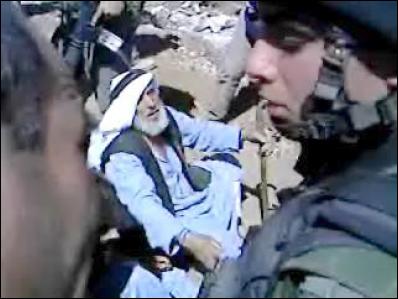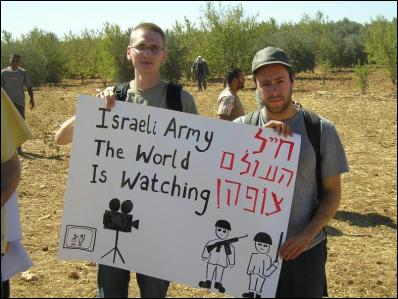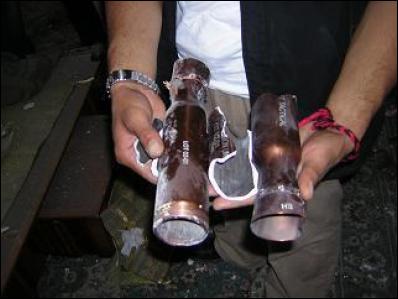Quiet is Not All Right: a Report on Hebron
Lokabandhu, September 2004
I visited Hebron between the dates of September 13th and 20th 2004, part of a group of 10 ISM activists which included 5 Buddhists from the UK. Tariq was our local coordinator. He is 24 years old, a student of engineering. I learnt that his father had been detained without trial by the Israeli army for the past 2.5 years, the rest of his family had emigrated to Jordan but that he was refused exit from Israel because of his father - who he is not allowed to visit.

Palestinian Farmer Protests Theft of his Land in Deir Samit.

Palestinian Resistance to the
Wall is Joined by International Activists.

Israeli Army Ammunition used in
Nablus Killing of Six Palestinians.
His top two projects for us were first to help local villages resist the Israeli Apartheid Wall that was being built on their land, and second to help the situation in the Old City, now almost a ghost town because of the great number of soldiers there and the difficulty of living so close to the aggressive Israeli settlers. This report focuses on the Old City not the Wall.
Topics:
Closure of Shuhadda Street to Palestinians Checkpoints and Soldiers patrols - Freedom of movement
Army closure of shops Continuous curfew for 3 years Death of the Old City market Settlers' harassment Process of colonization, extension of illegal settlements Tit-for-Tat violence Collective punishment Water rights – Economic warfare Settlers' propaganda / Media blackout
Hebron is presently unique in the West Bank because it has a substantial illegal Israeli settlement (Beit Hadassah) right in the very centre of the Old City, creating a situation where the lives of some 60,000 Palestinians are systematically disrupted by some 4,000 soldiers for the sake of some 400 settlers. It is a ludicrous situation and would almost be funny if it was not so real and the cause of so much suffering for so many people. It is also a part of a much larger process of gradual illegal invasion and colonization.
During the time we were in Hebron the situation was relatively quiet and there was little for us to do except walk about the Old City meeting people and speaking with them. Most people were very friendly as soon as we said "Salaam Al-e-Qum" and smiled, however there was clearly a lot of tension in the air and some suspicion - probably because the settlers are in the habit of walking up and down 'their' city and there is a real fear of them extending their territory.
We were staying for a night in one of the further suburbs of Hebron, and when leaving in the morning, passed a little girl who started crying violently - we learnt later that she thought we were settlers! In general though we were made very welcome indeed - very few friendly foreigners find their way to Hebron these days.
Quiet it might have been, but I should emphasize very strongly that 'quiet' does not mean 'all right'. Once or twice in the silent streets I found myself thinking "this seems all right" and had to remind myself of the facts of the matter.
• Closure of Shuhadda Street to Palestinians
Despite Hebron being a part of Palestine and not Israel, the main street of the town (Shuhadda Street) is now completely closed to Palestinians, except for the very few who live there. This means the town is effectively cut into two halves, to cross those few yards means a detour of several kilometers. The town's graveyard is on the wrong side of the road, this means local people are unable to visit their family tombs.
Shuhadda Street has become a sort of mid-Western film set - hot, dusty, and empty, with guns never very far away. The only people who walk up and down it now are the settlers, who generally carry machine guns, even the young teenagers, strange to see them toting machine guns and their Jewish kippa caps on. This is quite scary to see, even for me, who was less likely to be shot at.
We were not able to speak to any settlers although we could probably have arranged it if we had wished, being Internationals. It was clear however that there is absolutely no communication between locals and settlers. The soldiers are supposed to be there to keep the peace between the two sides but this seems to mean keeping the locals firmly to the edges and allowing the settlers to walk where they please. Certainly the Palestinians do not see the soldiers there to keep the peace, rather to dominate them.
•Checkpoints and Soldiers patrols
Behind the main street are a maze of smaller streets leading up to the Old City. These can only be reached by passing an army checkpoint continuously manned by soldiers with machine guns, making passage into the Old City a nerve-wracking affair.
Most days however, what is in a way worse than the machine guns is the arbitrariness of the soldiers: they can detain any Palestinian at any time for any or no reason, and often do, making them sit at the side of the road in the hot sun for many hours at a time.
Not surprisingly people have chosen to avoid the area, and the town's main market has moved about 1km away.
In addition to the checkpoints, in the narrow streets of the Old City there are frequent 6-man soldiers' patrols, before they enter you can hear them lifting their machine guns into firing position and cocking the trigger. No doubt they are afraid themselves but it is very intimidating to hear.
Hebron is well-known among international aid agencies, we met CPT (the Christian Peacemaker Team) and TIPH (the Temporary International Presence in Hebron) while there. TIPH's job is to monitor and report on the situation, CPT intervenes more actively if local people are being harassed.
• Army closure of shops
As well as the checkpoints and the patrols, about 200 of the Old City shops have been summarily closed by military order, and many houses have had their front doors welded closed by the army. This means that in some cases the owners can only enter and leave their homes through a window at the rear of the house, or over the rooftops.
• Continuous curfew for 3 years
In addition to the checkpoints, the patrols, and the closed shops, the Old City has suffered from a strict curfew for three of the past four years. An Israeli army curfew generally means that the soldiers have orders to shoot to kill on sight, it creates an extremely dangerous situation for any person to go anywhere at any time, even outside the official curfew hours. This includes delivery of basic supplies of food and medicine, and also the movement of children, who are as likely to be shot as adults under a curfew.
Who can blame the shopkeepers and market stallholders for moving?
Although the curfew is not presently in force,
evidence of the effects of Army violence and
repression is everywhere - bullet holes in shopfronts,
cobwebs on the fronts of shops...
Although things were quiet, the Army has retained all its observation and sniper positions around the city - many of the most strategic buildings have camouflage netting draped over the top balcony or steel observation posts perched on the roof. We were told that in reality sniper positions are often concealed, but occupied or not, the visible ones create a constant and frightening reminder that the city is under armed occupation and that curfew can be reimposed at any time.
• Settlers harassment
In addition to the checkpoints, the patrols, the closed shops and the curfew, we heard a great many reports of vandalism and verbal abuse by the settlers.
In many cases the houses of the settlers directly overhang the streets of the Old City, and here the locals have had to fit thick metal mesh across the streets to catch the rubbish that has been thrown out of the settler's windows onto the street - and the Palestinians - below. In several cases the metal mesh was sagging due to the weight of debris above. It is of course impossible for me to say what motives the settlers may have for throwing rubbish in this way - had they wished to continue being malicious t hey could have thrown foul water, but I did not hear of this being done. Nonetheless they must have known full well that the streets below their windows were Palestinian streets. A lot of Palestinian windows were smashed, apparently by stones often thrown by settlers' children.
These all combined - together with the real violence of recent years - have made the whole of the Old City into a ghost town. The reason given by the Army is always "security", but one feels the real aim is colonization, certainly the effect is depopulation of the Old City through fear and strangulation.
These processes of displacement and harassment have not ended yet.
• Process of colonization, extension of illegal settlements
On the outskirts of Hebron is the much larger illegal Israeli settlement of Qiryat Arba. For those interested, this means 'Town of the Four', referring to the four biblical couples reported to be buried here in the Cave of Machpelah under the Ibrahami Mosque - Adam and Eve (!), Abraham and Sarah, Isaac and Rebecca, and Jacob and Leah. This biblical fame explains a good deal of why the city has become such a battleground and focus for extremist Israeli settlers - it is the no.2 site in Palestine for both Jews and Muslims. The locals probably wish it had never been mentioned! It was a women from Qiryat Arba who in 1979 illegally occupied the old Jewish hospital of Beit Hadassah in Hebron's Old City, leading directly to its present death-like state.
• Settlers' harassment
Walking up to Qiryat Arba, and along the road which marks the border between Israeli and Palestinian areas, one sees graffiti which has been sprayed on the doors of many Palestinian homes - Stars of David and angry writing in Hebrew (which I have not yet been able to translate but will). The feeling I get is that the graffiti is saying "you're next..." and I can imagine that it is extremely intimidating to receive. It is in fact eerily similar to tactics used by the Nazis in Germany, not a happy thought.
Of course you can dismiss provocative graffiti as being 'only' spray paint, more concretely there are plans afoot for a new Israelis-only road to link Qiryat Arba with the Cave of Machpelah and one can be sure that it will not be long before it is extended a few yards further to the illegal settlement in the heart of the city. Up on the border road, there are plans to construct a new Jewish synagogue on the Muslim side immediately adjacent to Muslim homes. This is presently being blocked by the Israeli authorities - but it is probably only a matter of time until they arrange the necessary military cover - ie a new Army checkpoint or base - and it goes ahead!
Hebron has a long history with ownership moving between Jews and Muslims many times over the centuries. For this reason, since the Jews started their illegal settlements in the area there have been major propaganda efforts to justify their right to be here, an Internet search looking for 'Hebron' or 'Beit Hadassah' will quickly lead you to some of these.
They consider their occupation of Hebron to be legitimate because there were Jews living there in the past, most recently in 1929 and most anciently when Abraham purchased the cave of Machpelah for his burial site sometime around 1,800 B.C! Their desire to live here would not be so bad if it was based on a desire to peacefully co-exist. Instead the settlers have gone on record as aiming to completely expel the Palestinians from Hebron or at least from its Old City. This is no idle threat as the 4,000 soldiers based here constantly remind one.
• Tit-for-Tat violence
Over the years there has been a great deal of violence in Hebron, not least in 1994 when Baruch Goldstein, a settler, entered the mosque and massacred 29 Muslims while they were at prayer, wounding a further 200. According to my guidebook, there is now a shrine to him in the adjacent illegal Israeli settlement of Qiryat Arba. The guidebook (Lonely Planet) describes him as "a popular settler hero". Not surprisingly there has been a good deal of tit-for-tat violence over the years, but with the massive army presence in town it is mostly Palestinian civilians who are injured or killed.
Palestinian suicide bombers have certainly killed settlers over the years, and this led to an Israeli Army invasion of whole district & city in 2002 - after similar invasions of Jenin, Tulkarm, etc. We were told that the Israeli Army becomes nervous if it is not able to operate inside a city. The invasion is partly a tactic to expose & kill - to 'flush out' - the most active resistance fighters.
• Collective punishment
As well as being in the Old City, we spent some time in other areas of Hebron, and it was here that it was most obvious that what is happening on Hebron's Old City is part of a much larger violent occupation of the whole country. The reality of the situation is not immediately apparent to the naked eye, you have to have things explained by a local. For instance, there are many gaps or piles of rubble between the houses. Why?
Collective punishment has been very much used by the Army, this usually takes the form of blowing up or bulldozing the family home of anyone who has been discovered to be a suicide bomber or other form of fighter. To give an example, we stayed in a house in the suburbs, next door there was an empty space with a big pile of rubble. On asking, we were told that this house was blown up by the Israeli Army some three months ago, the explosion was so violent that it blew in all the doors and windows on that side of our host's house. The family were living in a makeshift tent in one corner of the space. Across the small valley we could see a bulldozer working, we were told that was a house which had been blown up only last week. On the corner of the street was a small corrugated iron shop, the owner used to occupy a five-storey house on the site before that was blown up some years ago.
These are examples of collective punishment, which is specifically outlawed under international law and the Geneva Conventions, which prohibit the punishment of innocent people who may be connected with a 'guilty' party. Israel and her Supreme Court have consistently refused to uphold the Geneva Conventions and the illegality of its collective punishment, using a variety of reasons but notably that the Occupied Palestinian Territories (ie the West Bank) never constituted a sovereign state so Israel's invasion and occupation of Palestine do not count as the invasion and occupation of another country - and so international humanitarian law does not apply!
• Water rights – Economic warfare
Besides collective punishment, there is lower-level but on-going economic warfare being waged by Israel against the Palestinians. An example of this is water - Hebron has many natural springs, but local people are not allowed to use them. Instead they have to buy water at considerable cost, often delivered by tankers, while Israel helps itself to 80% of the water in the underground aquifers for intensive agriculture and 'modern' plumbing. .
• Conclusion
We went to Hebron at Tariq's invitation, inspired by his vision of bringing life back into the Old City. He thought that our presence might give locals confidence to re-enter it in greater numbers. Maybe we had some effect, it is hard to be sure. One idea he had was to organize a daily 'boy's march' through the checkpoint (children below a certain age do not need ID) to generate momentum and confidence in entering the Old City, followed by us or others putting on a concert or other entertainment to draw in the locals.
One thing we realized while there was just how hard it is to actually DO anything faced with such overwhelming odds and where people have more-or-less got used to the wrongness of the situation. We felt very strongly Tariq's - and I am sure, thousands of others') acute frustration and yet puzzlement what to do.
ISM has now established a flat for volunteers in the centre of the Old City, as we left five others arrived, and hopefully they will build on what we have done so far. One day, Palestine will be free...
Lokabandhu (lokabandhu@buddhafield.com)


 Mark Rabago, RNZ Pacific Commonwealth: Tinian Plays Central Role In CNMI Military Expansion
Mark Rabago, RNZ Pacific Commonwealth: Tinian Plays Central Role In CNMI Military Expansion Global Jews for Palestine: Global Jews Demand International Pressure To Stop Starvation In Gaza
Global Jews for Palestine: Global Jews Demand International Pressure To Stop Starvation In Gaza ITUC: May Day 2025 - Take Back Democracy From The Billionaire Coup
ITUC: May Day 2025 - Take Back Democracy From The Billionaire Coup Palestine Solidarity Network Aotearoa: New Zealand 'Nowhere To Be Seen - Again' - On Intensifying Gaza Genocide
Palestine Solidarity Network Aotearoa: New Zealand 'Nowhere To Be Seen - Again' - On Intensifying Gaza Genocide UN News: World Leaders Rally For ‘Full-Speed’ Climate Action Ahead Of COP30
UN News: World Leaders Rally For ‘Full-Speed’ Climate Action Ahead Of COP30 University of Queensland: World-First Immunotherapy Trial To Treat Type 1 Diabetes
University of Queensland: World-First Immunotherapy Trial To Treat Type 1 Diabetes